Class 12 Biology Chapter 11 Biotechnology: Principles and Processes The answer to each chapter is provided in the list so that you can easily browse through different chapters Assam Board HS 2nd Year Biology Chapter 11 Biotechnology: Principles and Processes Question Answer.
Class 12 Biology Chapter 11 Biotechnology: Principles and Processes
Also, you can read the SCERT book online in these sections Solutions by Expert Teachers as per SCERT (CBSE) Book guidelines. These solutions are part of SCERT All Subject Solutions. Here we have given Assam Board Class 12 Biology Chapter 11 Biotechnology: Principles and Processes Solutions for All Subjects, You can practice these here.
IV. Long Questions 5 Marks :
Q.1. EcoRI is used to cut a segment of foreign DNA to form a recombinant DNA. Show with the help of a diagram.
Ans : Endonuclease cut DNA at specific point to separate certain sequence of base pair nucleotides. It therefore must recognise the Palindromic nucleotide sequence in DNA before cutting. The sequence are either 5′ → 3′ or 3′ → 5′ and may contain a few to they base pairs.
There are types of endonucleases – Type I, Type II and Type III which cut sequence at different base pairs. Of these the types II remarkable for their palindrome. They are also very stable. In palindrome, the base sequence such that if read from both end they appear to be same.
5′ GAA ↑ AAG 3′ 5° GAA ↑ AAG 3′
Single Stand DNA 3′ CTT | TTC 5′
Double Stranded DNA
(If read from right to left and left to right it will be the same sequence in both strands)
In palindrome with rotational symmetry the base sequence in the first half of one strand DNA double helix is the mirror image of the second half of its complementary stand. Thus the base sequence in both the strands read the same when read from 5′- 3′ end and 3′-5′ end both sands. Thus the recognition sequence of ECORI are
5′ → 3′ or 3′ → 5′
5′ GAA | TTC 3′
3′ CTT | AAG 5″
ECORI recognition site
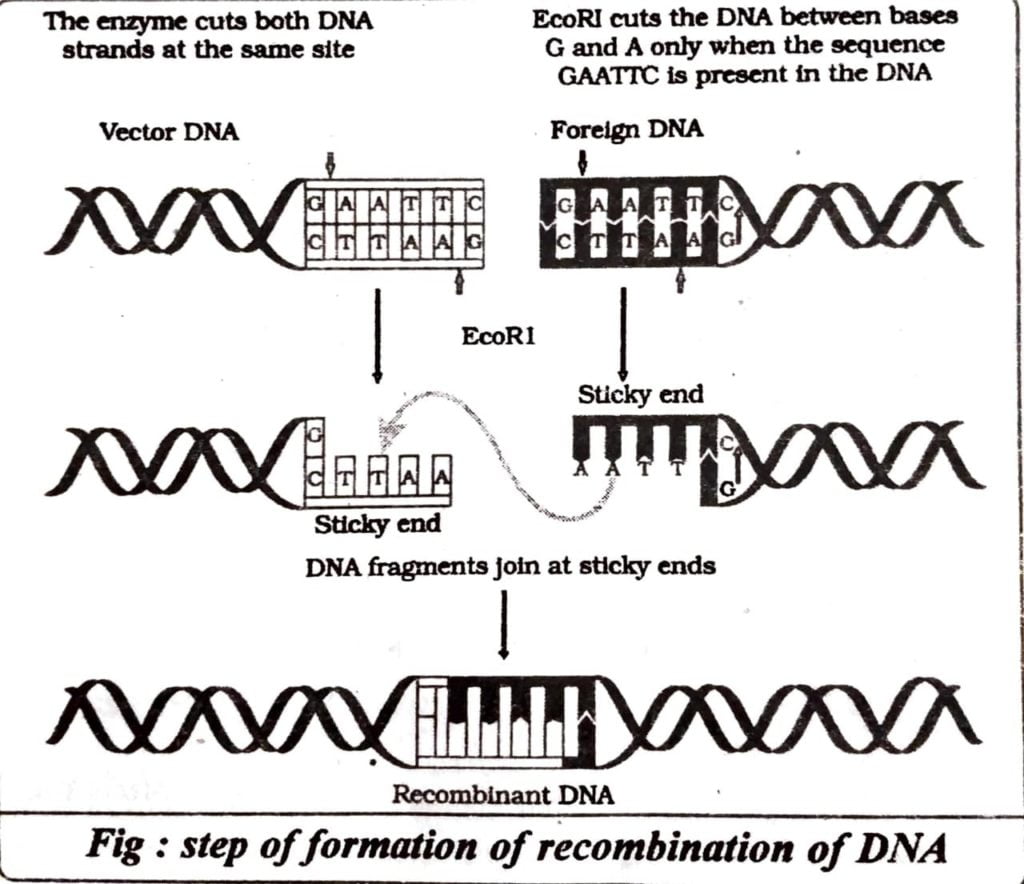
Q.2. What is polymerase chain reaction and how can it be utilized for gene amplification.
Ans : The polymerase chain reaction or PCR multiplies copies of DNA or its segments in vitro using two sets of primers which are small chemically synthesized oligonucleotides complementary to the regions of DNA and an enzyme called DNA polymerase. The enzyme polymerase extend the primers using nucleotides provided in the reaction and the DNA part provided as template. The process of replication can be repeated and a billion copies of the DNA can be multiplied. Thus a small fraction of DNA can be multiplied for study and use in genetic engineering. The following procedure is applied for obtain multiple copies of DNA.
At the start of PCR, the DNA from which a segment is to be amplified, an excess of the two primer molecules, the four deoxyriboside triphosphates and the DNA polymerase are mixed together in the reaction mixture. The following operations are now performed sequentially.
Step 1: The reaction mixture is heated to a temperature (usually 90-98°C) that assures DNA denaturation.
Step 2 : The mixture is now cooled to a temperature (generally 40-60°C) that permits annealing of the primer to the complementary sequences in the DNA; these sequences are located at the 3 ends of the two strands of the desired segment. This step is called annealing.
Step 3 : The temperature is now so adjusted that the DNA polymerase synthesizes the complementary strands by utilizing 3′-OH of the primers; this reaction is the same as that occurs in vivo during replication of the leading strand of a DNA duplex. The primers are extended towards each other so that the DNA segment lying between the two primers is copied.
The completion of step 3 completes the first cycle of amplification; each cycle may take few (ordinarily 1-3) minutes.
Step 4 : The next cycle amplification is separated the newly synthesized DNA strands from the old DNA strands.
Step 5 : Annealing allows the primers to base pair with both the new and did strands, the total number of strands being twice their original number.
Step 6 : Synthesis of new strands takes place, which doubles the number of copies of the desired DNA segment present at the end of step 1. This completes the second cycle.
Thus at each cycle, both new and old strands anneal to the primers and serve as templates for DNA synthesis. As a result, at the end of each cycle, the number of copies of the desired segment becomes twice the number present at the end of the previous cycle. Thus at the end of n cycles 2n copies of the segment are expected; the real values are quite close to this expectation. The cycle may be repeated.
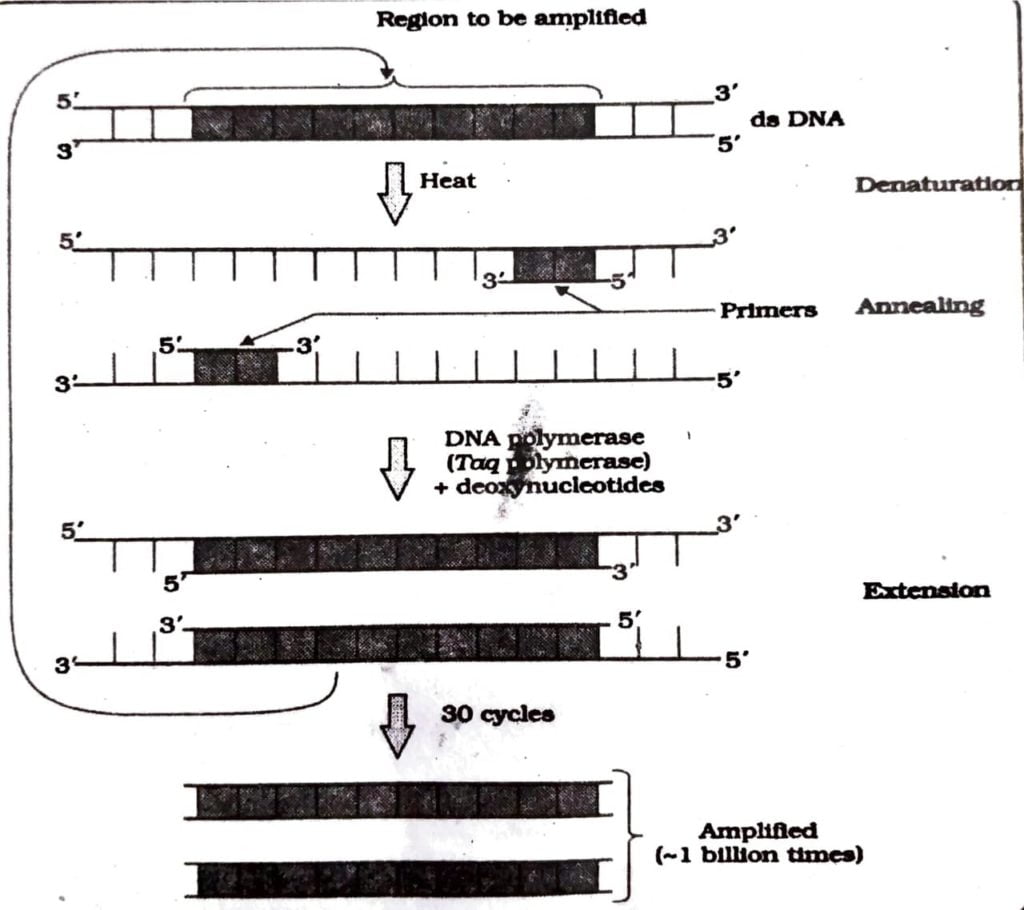
Q.3. What are molecular scissors? Explain their role in the process of recombinant DNA technology.
Ans : Exonuclease and endonuclease are called molecular scissors as they cut the DNA at specific base pair to separate DNA fragments for cloning purposes. These are actually enzymes. Exonuclease cut DNA at the ends that endonuclease cut DNA away from the ends. Before separating the required DNA fragment they recognise the sequence of base pair of nucleotides. As the surgery is done at molecular level these enzyme are called molecular scissors.
Endonuclease cut DNA at specific point to separate certain sequence of base pair nucleotides. It therefore must recognise the Palindromic nucleotide sequence in DNA before cutting. The sequences are either 5′ → 3′ or 3′ → 5′ and may contain a few to they base pairs.
There are 3 types of endonucleases – Type I, Type II and Type III which cut sequence at different base pairs. Of these the types II remarkable for their palindrome. They are also very stable. In palindrome, the base sequence such that if read from both end they appear to be same.
5′ GAA ↑ AAG 3′ 5° GAA ↑ AAG 3′
Single Stand DNA 3′ CTT | TTC 5′
Double Stranded DNA
(If read from right to left and left to right it will be the same sequence in both strands)
In palindrome with rotational symmetry the base sequence in the first half of one strand DNA double helix is the mirror image of the second half of its complementary stand. Thus the base sequence in both the strands read the same when read from 5′ – 3′ end and 3′ – 5′ end both sands. Thus the recognition of ECORI sequence are
5′ → 3′ or 3′ → 5′
5′ GAA | TTC 3′
3′ CTT | AAG 5″
ECORI recognition site
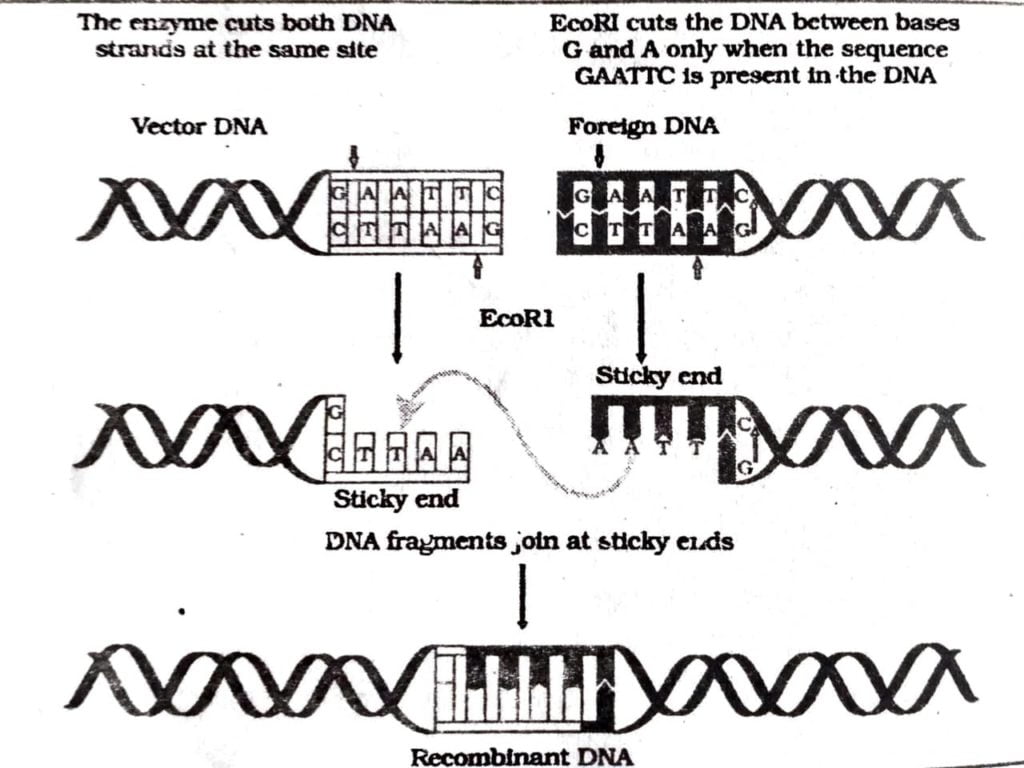
Q.4. Any recombinant DNA with a desired gene is required in billion copies for commercial use. How is the amplification done? Explain.
Ans : The polymerase chain reaction or PCR multiplies copies of DNA or its segments in vitro using two sets of primers which are small chemically synthesized oligonucleotides complementary to the regions of DNA and an enzyme called DNA polymerase. The enzyme polymerase extend the primers using nucleotides provided in the reaction and the DNA part provided as template. The process of replication can be repeated and a billion copies of the DNA can be multiplied. Thus a small fraction of DNA can be multiplied for study and use in genetic engineering. The following procedure is applied for obtain multiple copies of DNA.
At the start of PCR, the DNA from which a segment is to be amplified, an excess of the two primer molecules, the four deoxyriboside triphosphates and the DNA polymerase are mixed together in the reaction mixture. The following operations are now performed sequentially.
Step 1: The reaction mixture is heated to a temperature (usually 90-98°C) that assures DNA denaturation.
Step 2 : The mixture is now cooled to a temperature (generally 40-60°C) that permits annealing of the primer to the complementary sequences in the DNA; these sequences are located at the 3 ends of the two strands of the desired segment. This step is called annealing.
Step 3 : The temperature is now so adjusted that the DNA polymerase synthesizes the complementary strands by utilizing 3′-OH of the primers; this reaction is the same as that occurs in vivo during replication of the leading strand of a DNA duplex. The primers are extended towards each other so that the DNA segment lying between the two primers is copied.
The completion of step 3 completes the first cycle of amplification; each cycle may take few (ordinarily 1-3) minutes.
Step 4 : The next cycle amplification is separated the newly synthesized DNA strands from the old DNA strands.
Step 5 : Annealing allows the primers to base pair with both the new and did strands, the total number of strands being twice their original number.
Step 6 : Synthesis of new strands takes place, which doubles the number of copies of the desired DNA segment present at the end of step 1. This completes the second cycle.
Thus at each cycle, both new and old strands anneal to the primers and serve as templates for DNA synthesis. As a result, at the end of each cycle, the number of copies of the desired segment becomes twice the number present at the end of the previous cycle. Thus at the end of n cycles 2n copies of the segment are expected; the real values are quite close to this expectation. The cycle may be repeated.
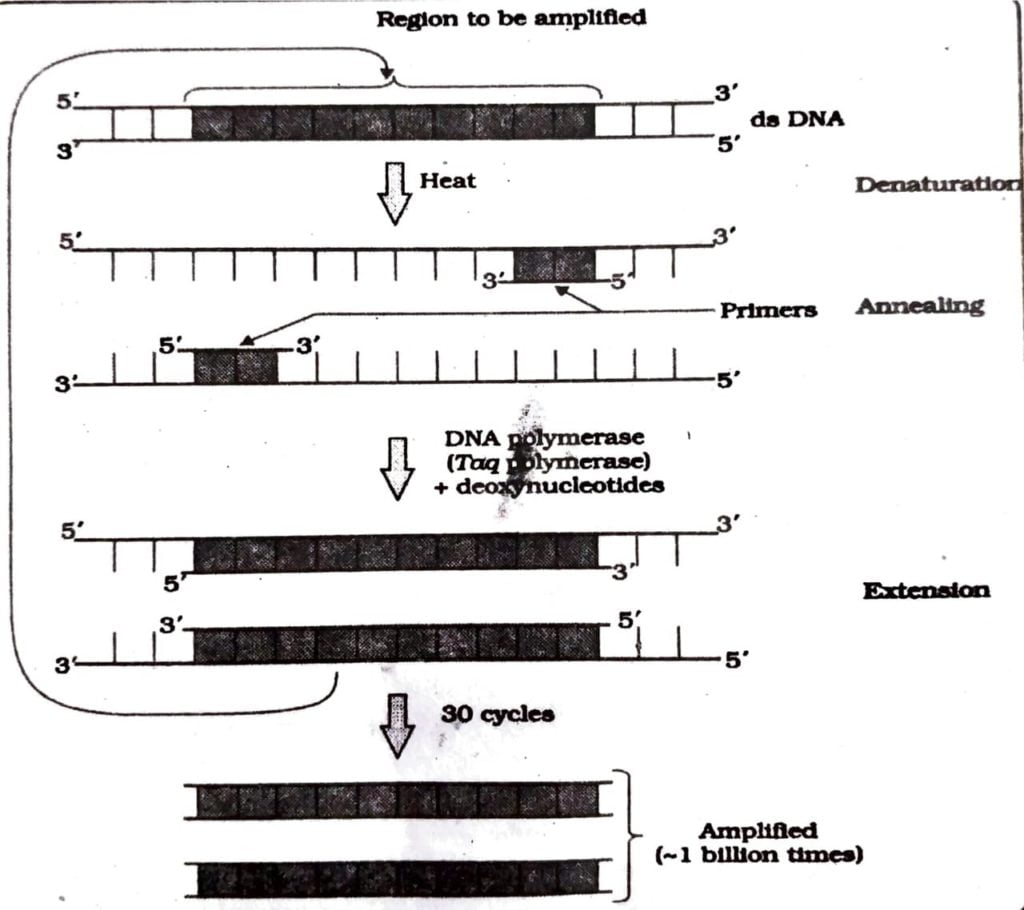
Q.5. Discuss the conceptual development of the principles of genetic engineering.
Ans : Genetic engineering deals with modification of organisms genetic makeup through a highly sophisticate technology that works at ultramicroscopic level to insert or remove nucleotide sequence DNA. The basic features of all organisms is code in the nucleotide sequence in the DNA. Gene is a part of DNA borne by chromosome. The nucleotide sequence of the DNA provides precise information about how certain organism should act and behave. Thus the nature of enzyme amino acid etc. are predetermined in an organism. A type of organisms. may be endowed with particular trait and others may not possess the same depending upon presence or absence particular nucleotide sequence which codes for a specific amino acid chain.
Similarly, certain genetic disorders are caused due to wrong sequence which code for wrong amino acid chain. Replacement of one base pair by another base pair or insertion of one extra pair or deletion of one base pair from DNA results in altered function of the 5. gene. Such minute alternation brings difference between life and death in case of many genetic diseases. Such alternation brings about change in functioning of an organism, its vigour and productivity. How such defective nucleotide sequence could be replaced by a normal one or how desired gene could be implanted in chromosome is the problem of genetic engineering. Genetic engineering can be defined as the science dealing with the correction of nature’s mistake at the level of hereditary unit-the DNA and to improve the quality of organism for specific purposes by implanting desired genes.
It can also be defined as a science dealing with adding to removing genetic units in order to achieve permanent and heritable changes in plants or animals for the benefit or mankind. The opening of a new revolutionary high-skill-technology of genetic engineering was possible due to hara work of Nirenberg, Khorana. Holley and Cohen during 1930-1975 at Massachusetts Institute of Technology and Stanford University of USA. With further work in progress the science of genetics has now become one of the most important applied sciences which will be able to guide the destiny of mankind. The technology has already reached a high level of skill. With further knowledge of the molecular nature of genes and of their capacity to manipulate cells of higher organisms, the possibility of artificial production of new and high yielding varieties of plants, animals and microorganism will further increase. The time is not far when genetic surgery and gene therapy will bring benefit to human society as well.
Genetic engineering so far is centered on to in vitro joining of DNA fragments of different origin with the help of some highly specific enzymes to produce recombinant DNA. Such recombinant DNA is then incorporated into the suitable host. The recombinant DNA technology as it is called has great potentiality in changing our society and in increasing production of food and other items.
The genetic engineering at present deals with a technique called gene cloning. It is the central feature of genetic engineering today. It involves isolation of suitable genes and incorporation of these in suitable hosts to allow their replication.
The technique involves the following steps :
(i) Isolation of required DNA, generally called donor DNA out of a (1) suitable organism (at present most works have been restricted to bacteria and virus) by biochemical technique.
(ii) Breaking of DNA into fragments using restriction enzymes.
(iii) Isolation of suitable bacterial plasmid (extra circular DNA present in many bacteria that are not part of chromosome but can replicate usually and inherit certain traits) and cutting it at a place by restriction enzyme and joining the donor DNA fragment with it with the help of an enzyme called ligase. The plasmid containing parent DNA and donor DNA is called recombinant DNA.
(iv) The recombinant DNA is then inserted within similar bacteria through cloning.
(v) Culturing of eloned bacteria containing fragment of donor DNA.
(vi) Selection of appropriate bacterial colony which has incorporated the sought after DNA fragment. For example, the different segments of DNA inserted in plasmid may cause bacteria to synthesize different substances. It is possible therefore to create bacteria acquiring ability to synthesize any substance like insulin, haemoglobin, interferon etc.
Genetic engineering is comparatively a new discipline of applied science, but within a snore span of time it has shown tremendous progress. Genetic engineering is the basis of biotechnology. Increasing the productivity of biological system, creating newer organisms and elimination of genetic defect from society are the basic aim of genetic engineering now.
Q.6. What is recombinant DNA technology ? Write a brief account of the process of recombinant DNA technology.
Ans : Recombinant DNA technology includes techniques of cutting DNA into specific fragments using enzymes restriction endonucleases and joining the fragments with the help of enzyme, ligase. Using this technology, the fragments of foreign DNA can be inserted into a vector which may be plasmids or viruses. This technology bypasses the restriction in the gene transfer mechanisms between unrelated organisms. Recombinant DNA technology or genetic engineering involves the following steps.
(i) DNA fragments coding for proteins of interest are synthesized 6. chemically or isolated from an organism.
(ii) These DNA fragments are inserted in a restriction endonuclease cleavage site of the vector that does not inactivate any gene required for vector’s maintenance.
(iii) The recombinant DNA molecules are now introduced into a host to replicate.
(iv) Recipient host cells that have acquired the recombinant DNA, are selected. Selection pressure is applied to enrich bacteria with a selectable market.
(v) Desired clones are then characterised to ensure that they maintain true copies of the DNA segment that was originally cloned.
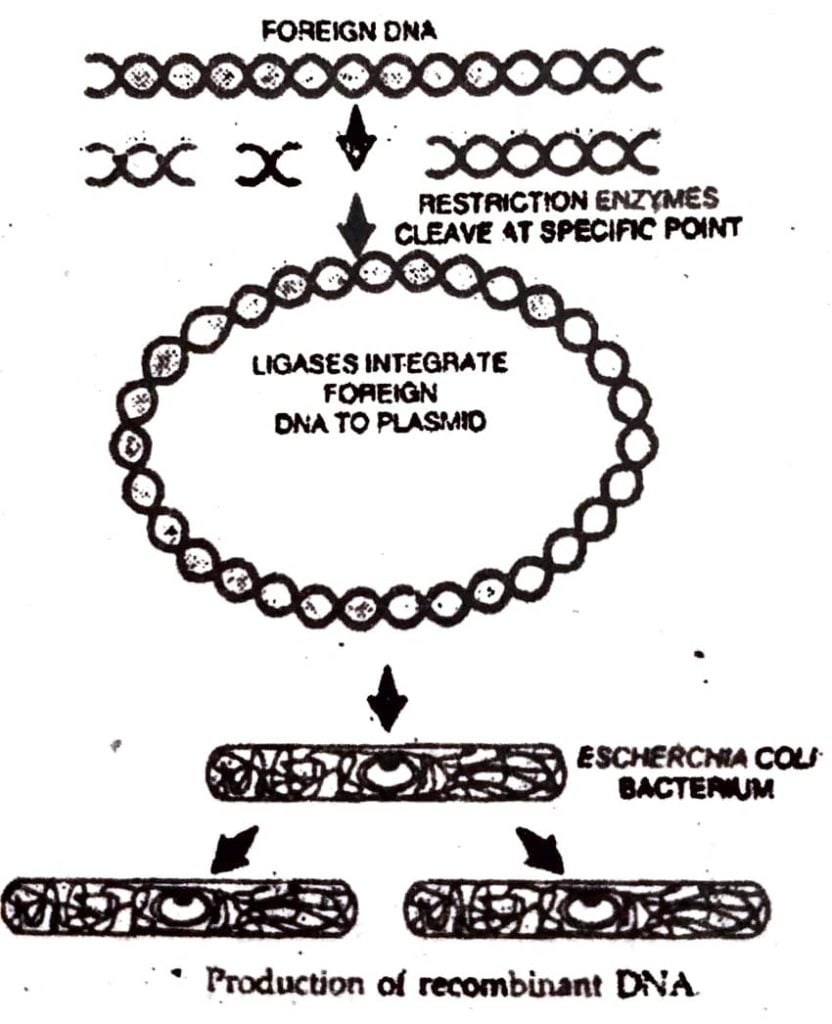
Q.7. What is bioreactor ? Draw a labelled diagram of stirred bioreactor and explain its functioning.
Ans : Structure: The basic design of a stirred-tank fermenter is shown below: It consists of a large stainless steel vessel with a capacity of upto 500,000 dm’ around which there is a jacket of circulatory water used to control the temperature within the fermenter. There is also an agitator, comprising of a series of flat blades, which can be rotated with the help of a motor. This ensures the thoroughly mixing of the contents so that nutrients come in close with the micro-organisms. The agitator also 7. sparged prevents settling out of the cells at the bottom.
Fermenter also has adequate arrangement for aeration, temperature and pH control. For proper aeration, air can be forced in at the bottom of the tank through a porous ring, called sparger, by the process called sparging, while there is an outlet to remove air and waste gases at the top of the tank.
The top of the tank also a number of inlet tubes called ports, through which materials can be introduced or withdrawn e.g.
– Inoculation port for introducing initial inoculum.
– Nutrient port for introducting more nutrients.
– Antifoam for port introducting antifoaming agents.
– pH port for introducing acid or alkali to maintain optimal pH.
At the base of the tank, there is a harvest line to extract culture medium and microbial products. To regularly detect the pH and temperature changes, tank is fitted with ceruan probes.
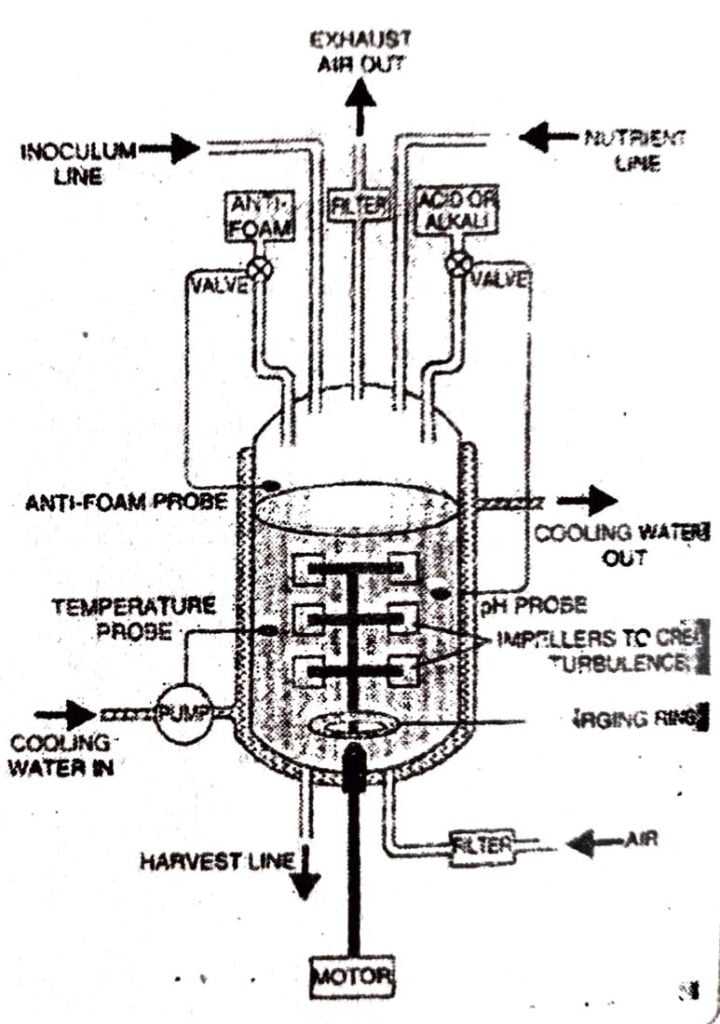
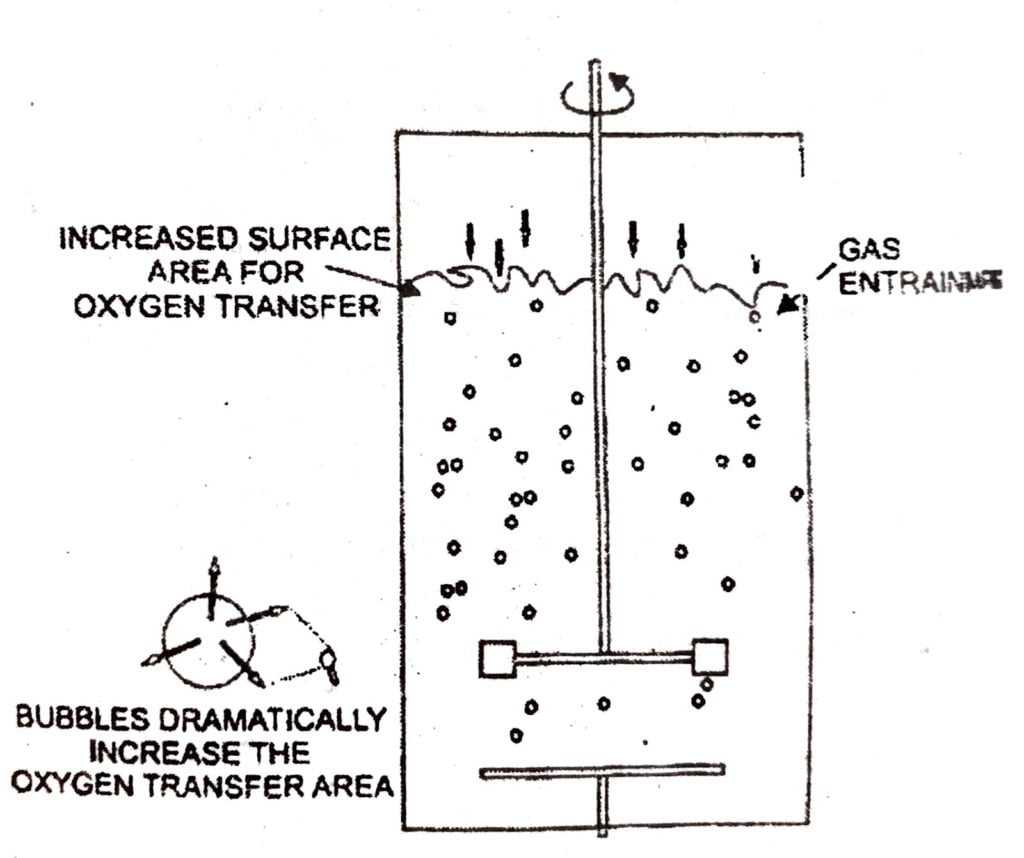
Significance : The bioreactor is a well tried and tested design for large scale production of micro organisms under aseptic condition and controlled environment for a number of days. Small scale fermenters of 10-100 lits Capacity are use in research laboratories. It is also provided with cortrols for the monitoring of physical, chemical and biological parameters that affect the growth of cells.

Hi, I’m Dev Kirtonia, Founder & CEO of Dev Library. A website that provides all SCERT, NCERT 3 to 12, and BA, B.com, B.Sc, and Computer Science with Post Graduate Notes & Suggestions, Novel, eBooks, Biography, Quotes, Study Materials, and more.





Hii, i wan’t to say that please make the answers in brief.. The answers are too long